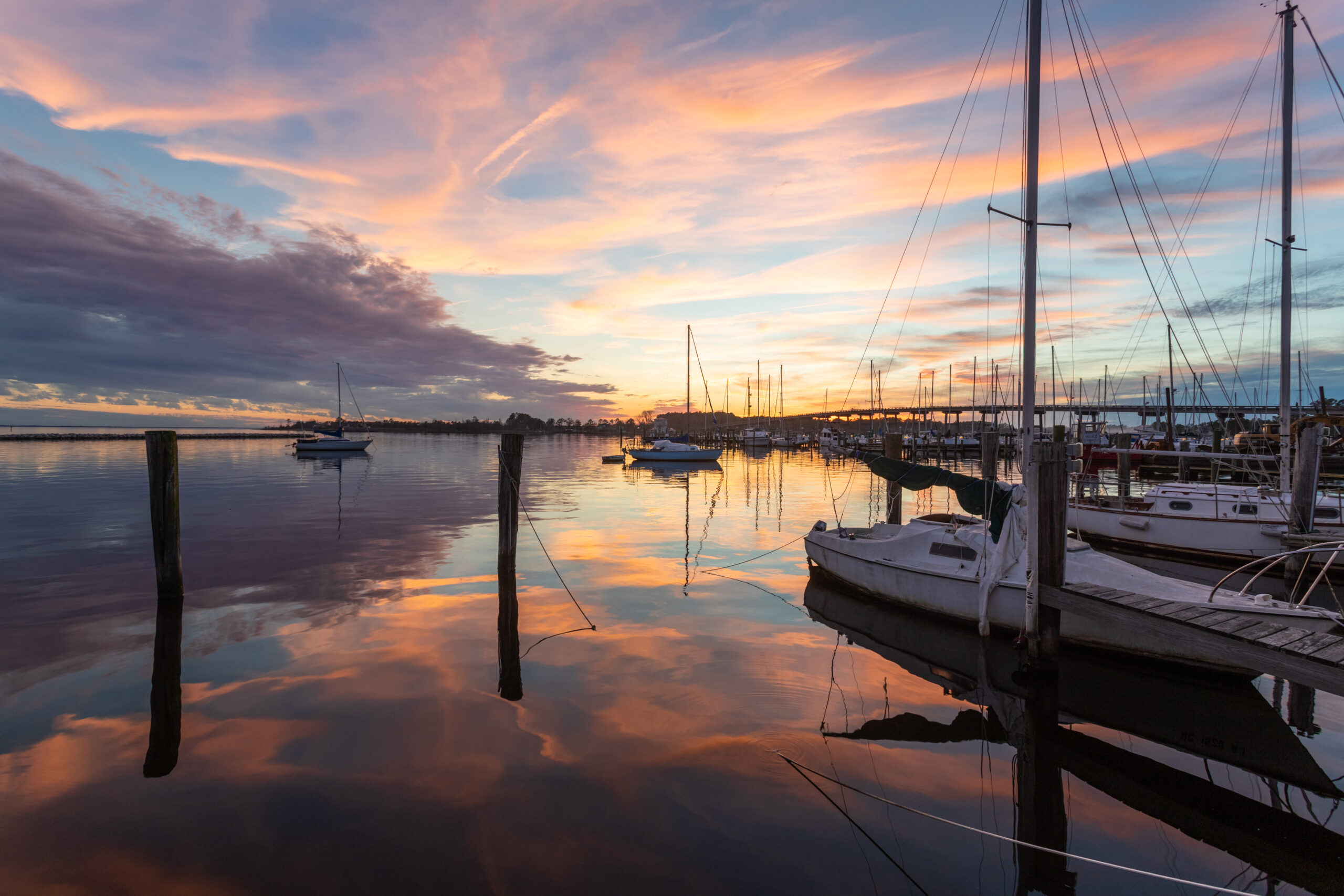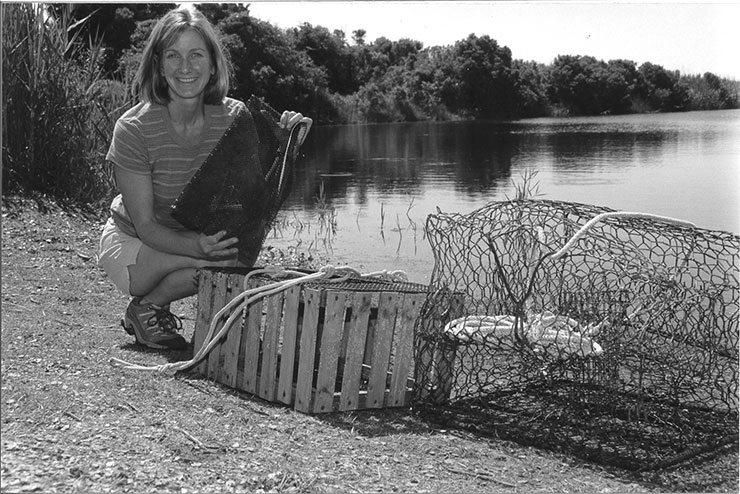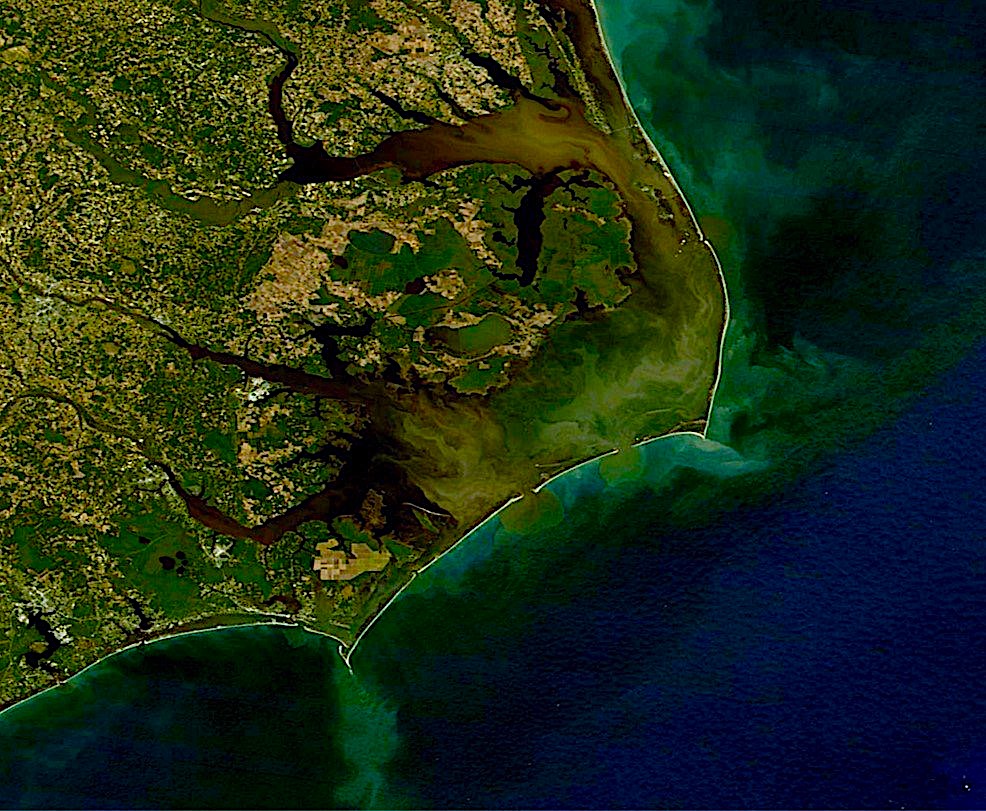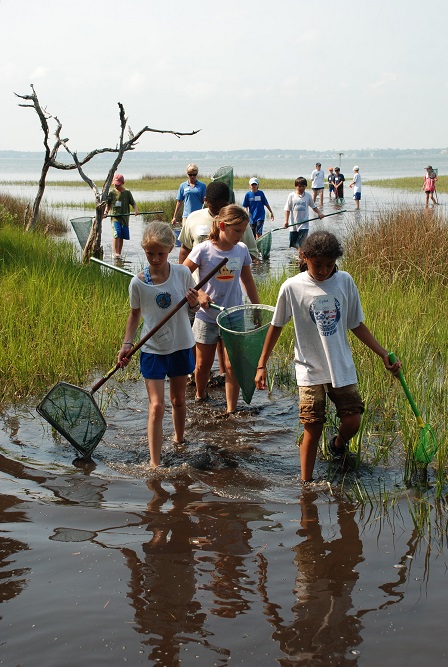At Mile Marker 182 on the Intracoastal Waterway, Oriental is one of those rare places on the North Carolina coast that seems unchanged by time. Through the years, it has remained true to its water-based genesis.
The village overlooks a wide stretch of the Neuse River near the entrance to the Pamlico Sound. Eight deepwater creeks outline the village and flow into the river.
Founded in 1872, its early residents fished, processed and shipped seafood, along with produce and lumber from area farms and timber operations. Oriental was a vital link for steamships hauling goods between Norfolk and New Bern.
The steamships are long gone. Commerce has shifted over time. Nevertheless, commercial fishing boats and a seafood processing plant still occupy the heart of Oriental’s waterfront.
The water provides a new income source: recreational boating. In fact, Oriental bills itself as “The Sailing Capital of the Carolinas.”
While the population holds steady at just under 900, the latest count puts the number of sail boats in and around Oriental at any one time at more than 2,000.
New businesses have emerged to cater to the transient and resident sailors, from ship stores to gift shops, restaurants and bed-and-breakfast inns.
Over the past two decades, many people have come to sail — some stayed.
The locals like to say that the “come here’s” don’t change the town, but rather, the town changes them: Slows them down. Exposes them to coastal hospitality that may take them by surprise — like the woman on Hodges Street who hangs clippers on the rose bush in her front yard and invites folks strolling by to help themselves to a fragrant, perfect bloom.
There’s a genuine neighborly feel to the place.
CLEAN MARINAS, GOOD NEIGHBORS
In a place that boasts thousand of sailboats, hundreds of recreational fishing boats and a host of commercial vessels, it’s little wonder that marinas and traditional marine trades thrive.
Business is good, but being a good neighbor is a top priority for Bob Deaton. He and his brother, John, own and operate Deaton Yacht Service Inc. on Whittaker Creek. Their two-acre operation is tucked into a residential waterfront neighborhood at the north end of the village.
Deaton’s was the first marina in the state to receive the Clean Marina designation from the N.C. Marine Trades Services and the N.C. Division of Coastal Management (DCM).
Flying the Clean Marina flag signals neighbors that they are safeguarding the environment, especially the quality of water — a shared community resource.
To qualify, marina operators must demonstrate that they voluntarily employ best management and operation techniques that go above and beyond regulatory requirements, explains Mike Lopazanski, DCM coastal and policy analyst.
“The Clean Marina Program is a national program that was adopted by North Carolina in 2000,” Lopazanski says. Unfortunately, budget and personnel cuts limited outreach efforts and only eight marinas in the coastal area fly the flag.
In the coming months, he plans to introduce the Clean Marina mission to more marina operators. For starters, Lopazanski is collaborating with the N.C. National Estuarine Research Reserve education staff to conduct workshops. The N.C.
Coastal Nonpoint Source Pollution Program is funding the workshops.
Also on tap is the distribution of a newly published “Best Management Practices Manual for North Carolina Marinas” that was prepared by the N.C. Marine Trades Services for DCM.
The take-home message of the effort is: protect coastal waters.
“Marina operators know the benefits to their business, their community and the environment. Beyond that, the Clean Marina program is a way to show boaters how they can minimize their negative impacts on the marine environment,” Lopazanski says.
Current Clean Marina operations, he adds, are models for other operators and boaters.
SHOW AND TELL
In some coastal states — including Texas, New York and Florida — Sea Grant programs are the lead agencies for the Clean Marina program. Here, North Carolina Sea Grant is playing a support role. Barbara Doll, Sea Grant water quality specialist, is working with Bill Hunt from North Carolina State University to develop a Clean Marina demonstration site to highlight a number of best management practices.
“Hopefully, things will get rolling by the early fall,” Doll says. “We also will conduct workshops to help marina operators learn how to design water protection measures into a marina project.”
Walter Clark, Sea Grant coastal community and policy specialist, is working on a project that could have broader implications.
“I am working with Gloria Putnam from the N.C. Coastal Nonpoint Source Program to look at the state’s marina policy — from the very definition of marina to the complex permit process.”
The marina development process begins with a permit application to DCM, but it involves 14 other state and federal agencies, each with various mandates and objectives when it comes to marinas, Clark says.
Often, just the legal definition of a marina can cause confusion. A marina is defined by DCM as any publicly or privately owned dock, basin or wet boat storage facility constructed to accommodate more than 10 boats, and providing any of the following services: permanent or transient docking spaces, dry storage, fueling facilities, haulout facilities and repair services.
“We hope to examine the process and develop recommendations that would clarify the state’s marina permit and management process while protecting our natural resources,” Clark says.
Now is a good time to take a long look at marina policies, Lopazanski says.
“The number of applications for marina permits has held at a steady 10 to 15 each year. However, we also have seen a large number of “nonmarinas” — multislip docking facilities with less than 10 slips,” he says.
“This is where you get into questions regarding what has the least environmental impact — individual docks associated with single family houses or community marina/docks that serve a larger residential area.”
The heart of the issue is considering the cumulative environmental impacts of any proposed marina.
“The demonstration project,” Lopazanski adds, “will show how upfront planning can go a long way towards the protection of coastal water quality.”
PRIDE AND PRACTICE
For his part, Bob Deaton says he feels great to have been the first Clean Marina in the state — a fact noted with pride on the company Web site.
“When we received the checklist, I looked at it and realized that we were almost there,” he says. “We set a goal that was easy to achieve without a lot of extra effort and expense. We already were doing our best to protect the water as a matter of company policy.”
Deaton chats as he heads toward the haul-out ramp at the end of the dock. He wants to check the status of emergency repairs on a boat that ran aground overnight at low tide.
Deaton Yacht Service is a TowBoat US provider, covering the region from the Neuse River to Ocracoke.
“We’re like AAA only on the water. It can get pretty exciting,” he says. “Last week, a fishing boat strayed into the military bombing range. The Coast Guard removed the people according to the rules. And we towed the boat out of the restricted area. It could be dangerous considering there are some unexploded bombs on the bottom of the sound.”
Deaton stops to give a progress update to Pat Webster, who sailed from Manteo to have work done on her hurricane-damaged boat, Warrior Woman.
“I had to wait for a break in the weather to sail,” Webster explains. The work will take several weeks to complete. She and her black lab will live on board for the duration. But she doesn’t mind.
“I feel safe and I love this marina — and Oriental,” she adds.
Down the line, dock repair is in progress. With timbers pulled away, a backhoe scoops dirt and loads it onto the bed of a dump truck. The goal is to prevent sediment from escaping into the water. “It’s all about reducing impact,” Deaton says.
He points out other Clean Marina practices that protect the water: grass buffers to catch run off from the paved areas; a vacuum system for dust generated by sanding; tarps under hauled out boats; a pump-out station and sewage holding tank for boaters; waste oil containment tank; barrels for used paint products; a parts wash collection center.
A licensed waste-management company collects all hazardous products for disposal, he explains.
“Water is our lifeline. It’s to our advantage to be the best environmental stewards possible. It’s just good for business and it’s good for fish,” Deaton insists.
ATTITUDE IS KEY
A fierce spring windstorm shredded the Clean Marina flag at Town Creek Marina in Beaufort. Owner-operator Chuck Tulevech was quick to call DCM for a replacement. He’s proud to display the flag that lets customers know that his business exceeds required measures to protect the environment.
“Our clients tend to be more conscious than ever before, and they don’t mind adhering to our strict rules,” Tulevech says. “Attitude and education are key.”
His four-acre marina straddles Town Creek and Gallants Channel, about 1.5 miles from the Beaufort Inlet. With 88 slips, the marina provides waste pump-out service; showers and laundromat; fish cleaning stations; dockside water and power connections; a ship’s store; and a full array of haulout repair and dry storage services. Marina services help clients obey the rules.
It’s a symbiotic relationship — clients who spend a lot of money on their boats don’t want to jeopardize their investment in a nasty boat yard or wet slip.
“We are all connected to and by the Neuse River, and it’s our shared responsibility to protect it,” Tulevech points out. “We just want to do things right.”
One obvious “right” measure is an elaborate on-site stormwater filtration system, designed to catch hazardous material from repair operations — sanding dust, antifouling paints, engine overhaul byproducts, oils, fuel, fiberglass materials. An aeration device keeps the 6-feet-deep lagoon from becoming a stagnant mosquito-breeding pond.
“The nature of our business is messy,” he notes. To further protect water quality, the messiest jobs are done at a satellite facility away from the waterfront.
Tulevech, a transplant from Port Jefferson, N.Y., purchased the marina in 1996 and recruited his younger brother, Steve, away from academic life to serve as vice president of operations.
Steve Tulevech is a marine biologist who taught and helped develop the marine resource management program at Richard Stockton College of New Jersey.
“A lot of people do business with Town Creek Marina because of the clean appearance of our operation,” says the younger Tulevech. “They don’t necessarily see our attention to detail, such as using waste filters to absorb oil or gasoline. But they do understand the hazards associated with runoff.”
There are industry challenges, such as protecting the environment from antifouling marine paints. He is testing a water-based bottom paint that will eliminate water and air contamination. “It will be good news all around if it works,” says Steve Tulevech.
A HIDDEN TREASURE
When Skip Fry purchased the Wilmington Marine Center in 1987, it was a diamond in the rough — a far cry from the model Clean Marina it is today.
“It was a utility yard, with a partial basin,” he recalls. “But I saw the potential to transform it.”
By water, the marina’s channel starts near Marker #59 on the Cape Fear River — about seven miles north of Snow’s Cut on the ICW, and three miles south of downtown Wilmington.
In other words, it’s a hidden treasure — a deliberate one at that. Fry purposely dug a basin on high ground to create an enclosed marina — a “hurricane hole” — that would be a safe harbor on the often stormy coast. His plan works. From Bertha to Isabel, no boat in his marina has been scratched.
Seeking the Clean Marina designation was not a stretch for Fry, one-time president of the Cape Fear River Watch.
“Conservation is a pervasive concept, from tarps under boats being serviced to impervious surfaces, and contracts to remove all waste products,” Fry says. “The marina was designed so that all runoff flows away from the water body.”
Fry also designed the overall marine operation according to function. The marina shares the waterside address with Baker Marine Sales and Service. Across River Road — well away from the water basin — Fry sited an industrial area that is home to DeMann Marine Power, Industrial and Marine Fabricating and Welding, Cape Fear Yacht Works, O.E. DuRant Ship Chandlers and Sound Marine.
Ken Trapagnier, who has been a “live aboard” at the marina since last August, appreciates the degrees of separation.
The former deputy fire chief from New Orleans retired early to enjoy life on board his 46-foot boat, In Dreams.
“I really didn’t know about the Clean Marina Program until recently,” he says. “But I always look for a clean environment. I have been to some places in the Caribbean that could definitely use stricter regulations to protect the water quality.”
Trapagnier will set sail in late summer for his next adventure at sea. He plans to return to the Wilmington Marine Center in the future because, he says, he appreciates the high standards of the Clean Marina program.
Fry runs a tight ship and is a self-proclaimed tough landlord — one who enforces strict rules that protect the environment.
“Our industry is predicated upon clean water,” Fry says matter-of-factly. “Without clean water, we have nothing.”
This article was published in the High Season 2004 issue of Coastwatch.
For contact information and reprint requests, visit ncseagrant.ncsu.edu/coastwatch/contact/.
- Categories:



